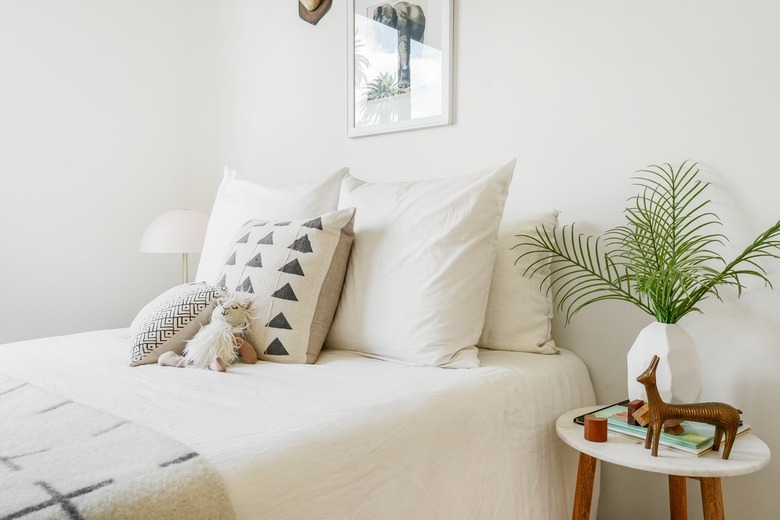Alternatives To Slats For Bed Frames
We may receive a commission on purchases made from links.
Headboards, footboards, and legs are all well and good, but it's the part of the bed frame that's hidden out of sight that truly keeps us from curling up on the floor below. This is the series of slats that cross the sides of the frame at equally spaced intervals, supporting the mattress and allowing us all a good night's sleep. Increasingly, there are folks who prefer to try out other types of beds — ones where the foundation isn't composed of these durable wooden boards. For these sleepyheads, there are a few options available.
Plat Over Slat
Plat Over Slat
One popular choice is the platform bed, which comes in many varieties. While some wood and steel frame bases are indeed slatted, many instead feature a solid framework. Because of the raised nature of these beds, a box spring is not needed underneath the mattress.
Many consumers prefer the solid platform bed because it's visually more dynamic in appearance, as the mattress often sits lower to the ground. It allows for a thick, plush mattress without the added height of a box spring. Depending on the style and height of the frame and platform, some solid platform-style beds have drawers or other storage space underneath, which is a great benefit for those seeking somewhere to hide their clutter.
Ply Your Trade
Ply Your Trade
Old-fashioned foam and newer memory foam mattresses tend to work better on solid platform beds than slatted beds, and the same rule applies to another popular alternative: plywood. A bed with a plywood base is similar to solid platform beds in that it offers a solid rectangle of wood on which to rest a mattress. A box spring is not necessary.
Adding a sheet of plywood that is cut to size and laid directly over the original slats is one way to make a solid support for the mattress. Alternatively, cut two or three 4 x 8-foot sheets to fit under a larger mattress, which may be up to 108 x 108 inches square if you own an Alaskan king-size bed. Add 2x4 boards under the plywood seams if necessary for more support. Inserting plywood under the mattress is admittedly harder and less flexible than slats, but for those with back problems who need the extra firmness and support, it might be just what the doctor ordered.
Become the Dream Weaver
Become the Dream Weaver
If you're feeling energetic and in a do-it-yourself mood, you might consider creating your own rope bed. Rope beds were reportedly popular in the days of yore, so anyone seeking to emulate the pioneers of the past will find this a sound option.
Rope beds create a weave much like a hammock. Unlike a hammock, however, the weave is so tight that a mattress can securely rest on top, creating an even sleeping surface. There are many different ways to tackle this project. Some employ a wood frame, while others opt for metal. Some weave the ropes, while others merely nail down the strands.
There are several videos that offer step-by-step instructions, so find the one that most strikes your fancy. If the project ends up being too overwhelming, rest assured that there are some manufacturers selling already-assembled rope beds.
References
- Sleep Buffs: Platform Bed Slats vs Solid: Your Best Platform Bed Choices
- YouTube: India Wild Films – How to Weave a Rope Bed
- Terrys: Slatted Bed Base Vs Plywood: 6 Factors To Follow To Make The Right Choice
- Zoma: Wyoming King vs. Alaskan King vs. Texas King: What's the Difference?
- Curtis Lumber & Plywood: What Size Does Plywood Come In?
- Greydragon: A Transportable Rope Bed
